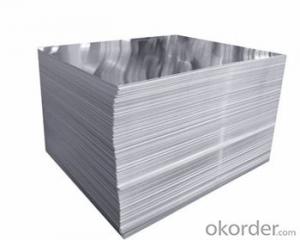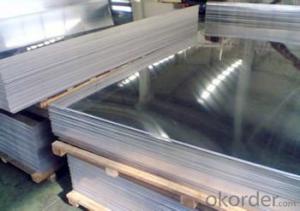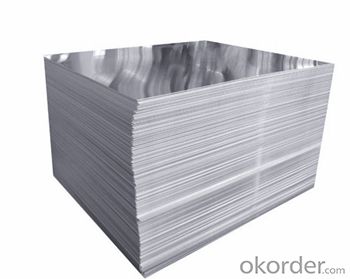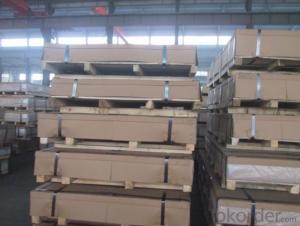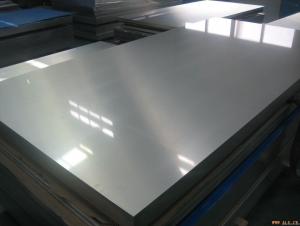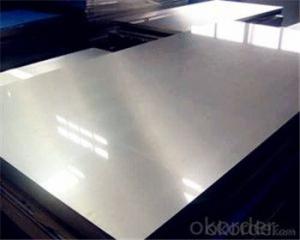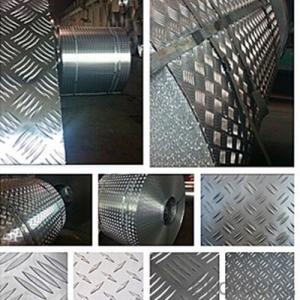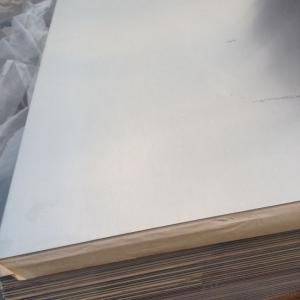High Quality 1100 Aluminum Coated Mylar Plastic Sheets with a Good Price
- Loading Port:
- Qingdao
- Payment Terms:
- TT OR LC
- Min Order Qty:
- 10000 kg
- Supply Capability:
- 100000 kg/month
OKorder Service Pledge
OKorder Financial Service
You Might Also Like
Specification
1100 Aluminum Sheet
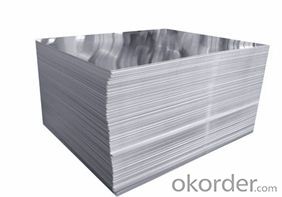
1100 Aluminum Sheet Introduction
1100 aluminum sheet belt belong to the pure aluminum plate series, its strength is relatively low, with excellent ductility, formability, weldability and corrosion resistance; anodic oxidation can further improve the corrosion resistance, while obtaining a beautiful surface; but can not be strengthened by heat treatment.
Pure aluminum sheet series according to the last two Arabic numerals to determine the minimum aluminum content of this series, such as the 1100 series of the last two Arabic numerals 00, according to the international brand naming principle, aluminum content must reach more than 99.00% for qualified products. China's aluminum alloy technical standards (GB / T3880-2006) also clearly stipulates that 1100 aluminum content reached 99.0%.
1100Aluminum Sheet Application Scope
1100 aluminum sheet belt are commonly used in the artifacts, heat sinks, bottle caps, printing plates, building materials, heat exchanger components, and can also be used as deep stamping products. Is widely used in various fields from cooking utensils to industrial equipment.
1100Aluminum Sheet Picture
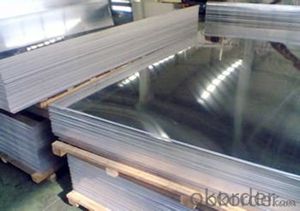
1100 Aluminum Sheet Technical parameters
| Alloy | 1100 Aluminum sheet |
| Temper | O,H14,H16,H18,H22,H24,H26 |
| Thickness (mm) | 0.2 ≤ T≤ 1.0 |
| Width (mm) | 820 ≤ W ≤ 1200 |
| Length (mm) | 1000 ≤ L ≤ 3000 |
| Tensile strength σb (MPa) | 110-185 |
| Elongation rate δ10 (%) | 3-15 |
| Chemical Composition | Al :99.00 Si :0.25 Cu :0.05-0.2 Mg:0.05 Zn:0.01 Mn:0.05 Ti :0.03 Fe: 0.350 |
| Typical products | Heat sinks, bottle caps, printing plates, cookware, building materials, heat exchanger components,etc |
Introduction of our company
Our company is a professional Aluminium Strip manufacturer and Aluminum Circles manufacturers,mainly supply Aluminium Coil,Aluminum Circles,Aluminium discs,Aluminum Sheet,Aluminum Strip, Household Aluminum Foil,Aluminum Foil for Pharmaceutical Packaging,Aluminum Foil Tape,Aluminum Foil for Air Conditioner,Aluminum Foil for Container etc. series of aluminum products, sincerely welcome everyone to visit.
- Q: How to distinguish aluminum sheet from magnesium sheet?
- put them into acid and observe bubble's generating speed, the quicker one is magnesium sheet.
- Q: What are the typical thickness options for aluminum sheets?
- Depending on the specific application and industry requirements, the thickness options for aluminum sheets vary. However, a range of thicknesses is commonly available for aluminum sheets. Some of the most frequently used thickness options include 0.025 inches (0.635 mm), 0.032 inches (0.81 mm), 0.040 inches (1.02 mm), 0.050 inches (1.27 mm), 0.063 inches (1.6 mm), 0.080 inches (2.03 mm), and 0.125 inches (3.18 mm). These thicknesses are widely utilized in industries such as aerospace, automotive, construction, and manufacturing. It's important to note that specialty aluminum sheets may offer even thicker options, tailored to the specific requirements of a given project.
- Q: Can aluminum sheet be used for medical applications?
- Yes, aluminum sheet can be used for certain medical applications. Aluminum is a lightweight and durable material that is resistant to corrosion, making it suitable for various medical devices and equipment. For example, aluminum sheets can be used for manufacturing prosthetic limbs, braces, and orthopedic implants. Additionally, aluminum can be used in the production of medical instruments, such as surgical trays, sterilization containers, and imaging equipment. However, it is important to note that aluminum may not be suitable for all medical applications, as certain medical devices may require specific properties or materials to meet regulatory standards and ensure patient safety. Therefore, the use of aluminum sheet in medical applications should be determined on a case-by-case basis, considering the specific requirements and regulations of each application.
- Q: What does 1060h/24 mean in aluminium alloy?
- Each digit in the 1060-H24 stands for the following meanings:First, a number of Arabia 1 is representative of pure aluminum (aluminum is aluminum content above 99% aluminum, in addition to the beginning and start with 2-8 are 2### for copper and aluminum magnesium alloy, 3### aluminum manganese alloy, 4### alloy, 5### alloy and so on)Two, second, Arabia number 0, said the original alloy, such as 1, said the original alloy after a modification, 2 means that the original alloy after two modificationsThree, third and four 60 two Arabia data represent the value behind pure aluminum content of 99% per cent in pure aluminum, said 60 pure aluminum aluminum content of 99.60%, as the standard 1050 indicates the aluminum content of pure aluminum, 99.50% of the 1070 said that the aluminum content of 99.70% pure aluminum alloy in the back. In two the number of Arabia aluminum has no special meaning, is only used to identify the different alloys in the same group, said its second modifications.Four, H24 H said the work hardening of the state, and some do not have H but T said it is heat treatment.24 machining process control hardness and other properties, in addition to 24 and 12, 14, 16, 18, 22, 26, 34, 36 and so on, usually at the end of 4 is a semi hard state.1060O, 1060-H22, 1060-H24, 1060-H18 state is arranged from soft to hard.
- Q: Is it possible to utilize a custom-made door in place of a standard door within a construction or renovation project?
- <p>Yes, you can use a custom-made door to replace a standard door in your project. However, it's important to ensure that the custom door meets all the necessary building codes and specifications required for your project. This includes considerations for size, material, fire resistance, insulation, and any other relevant standards. Additionally, you should consult with your architect or contractor to confirm that the custom door will fit properly within the existing framework and align with the overall design and functionality of the space.</p>
- Q: This question asks for methods to maintain a smooth and even surface finish on an aluminum sheet after it has been installed.
- <p>To ensure a smooth and even surface finish on an aluminum sheet after installation, follow these steps: 1. Choose high-quality aluminum sheets with a consistent thickness and surface texture. 2. Use appropriate cutting and shaping tools to avoid scratches and deformations. 3. Clean the surface thoroughly before installation to remove any dirt or debris. 4. Apply a protective coating or sealant if necessary, following the manufacturer's instructions. 5. Install the aluminum sheet using proper techniques and hardware to avoid warping or unevenness. 6. Inspect the surface regularly for any signs of wear or damage, and address them promptly. By following these steps, you can maintain a smooth and even surface finish on your aluminum sheet after installation.</p>
- Q: Does anyone know why Mercury -(Thimerosal) is used in Flu Vaccinations and where Mercuryisnot used Aluminium in other vaccines ? While these are known to be toxic metals, can these cause headaches, severe hot burning heads and or Sinusitus ?
- Toxicity is about dose. The dose of mercury in the flu vaccine is minute and cannot possibly contribute to mercury poisoning. In any case, Thimerosal converts to ethylmercury in the body which is quickly broken down and excreted - unlike methylmercury which is the mercury you are thinking about. A tuna fish sandwich will give you more mercury than any vaccine. Thimerosal is a preservative basically, which is why it is added to the multi-dose vial. If you are that paranoid about it, ask for the single dose vial to be used.
- Q: How does the thermal conductivity of aluminum compare to other metals?
- Aluminum has a relatively high thermal conductivity compared to many other metals. It is surpassed only by a few metals such as copper and silver, which have even higher thermal conductivity values. However, aluminum's thermal conductivity is still significantly higher than most other commonly used metals.
- Q: How do you prevent discoloration of aluminum sheets?
- In order to avoid discoloration of aluminum sheets, there are a few steps that can be taken. First and foremost, it is crucial to regularly clean the aluminum sheets to eliminate any dirt or debris that may potentially cause discoloration. Utilize a mild detergent or a specialized aluminum cleaner, along with a soft cloth or sponge, to gently scrub the surface. It is advisable to refrain from using abrasive cleaners or scrubbing pads, as they have the potential to scratch the surface and increase the likelihood of discoloration. Secondly, it is essential to thoroughly rinse the sheets after cleaning to eradicate any residue from the cleaning products. Residual chemicals can react with the aluminum and result in discoloration over time. Another preventive measure entails applying a protective coating or sealant on the aluminum sheets. This can establish a barrier between the metal and the surrounding environment, thus preventing oxidation and discoloration. There are diverse types of protective coatings available, such as clear lacquers or anodizing treatments, which can enhance the durability and appearance of the aluminum sheets. Moreover, proper storage of the aluminum sheets is paramount to minimizing exposure to moisture, humidity, and extreme temperature fluctuations. Moisture can expedite the oxidation process and lead to discoloration. It is recommended to store the sheets in a dry and well-ventilated area, away from direct sunlight or sources of heat. Consistent maintenance is vital to prevent discoloration. Periodically inspect the aluminum sheets for any indications of discoloration or damage, and promptly address any issues that arise. By adhering to these preventive measures, the aesthetic appeal and longevity of aluminum sheets can be maintained.
- Q: Can aluminum sheets be plasma cut?
- Indeed, aluminum sheets are able to undergo plasma cutting. The technique of plasma cutting presents itself as a versatile and highly effective method capable of cutting various materials, including aluminum, with great efficiency. By utilizing a high-speed stream of ionized gas, commonly referred to as plasma, the aluminum sheet can be meticulously shaped and tailored to meet specific requirements. Plasma cutting boasts a multitude of advantages, such as faster cutting speeds, more precise cuts, and significantly reduced heat-affected zones, in contrast to traditional cutting methods. As a result, it has become a widely utilized technique in numerous industries, including automotive, aerospace, and construction, for the purpose of cutting aluminum sheets of varying thicknesses.
Send your message to us
High Quality 1100 Aluminum Coated Mylar Plastic Sheets with a Good Price
- Loading Port:
- Qingdao
- Payment Terms:
- TT OR LC
- Min Order Qty:
- 10000 kg
- Supply Capability:
- 100000 kg/month
OKorder Service Pledge
OKorder Financial Service
Similar products
Hot products
Hot Searches
Related keywords
